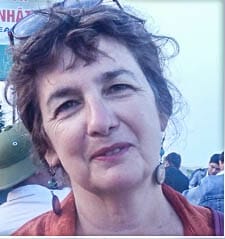On pointe quick quick quick with tutu bounce‑—this was the finale piece and predictable crowd pleaser The Vertiginous Thrill of Exactitude, set to the fast clip of the last movement in Schubert’s Symphony in C major. Any ballet audience regular – from Rome to Rio to Moscow and beyond—knows that any tutu number will always find its fan base in a loudly expressive segment of the ballet audience. This was no exception—bravas and bravos erupted long before the curtain bows. But for any Chicagoan, there was an added reason to feel like this work was a coming home moment. The choreographer of this piece, William Forsythe, is not only American but also one launched by Chicago’s own Joffrey Ballet.
Not unlike many of the other events presented in CAFeBUDAPEST celebration of culture, this performance by the Hungarian National Ballet was less about Hungarian culture per se, but more, perhaps, of a demonstration that Hungarian artists are part of a global arts community continuing the same conversations.
For this writer, it was in fact the opening, Walking Mad, which immediately communicated this world-of-ballet-window, coupled with the joy of watching yet another band of graceful and athletic dancers bringing choreography from other lands to life. In this case it is the work of Swedish choreographer Johan Inger, which has similarly charmed American dance troupes and their audiences as well. (Editor’s Note: Read a review of Alvin Ailey American Dance presenting this same work in Chicago’s Auditorium Theatre here.)
A male dancer emerges from an audience chair to walk onto the stage and lock eyes with a woman—somewhat beleaguered seeming—picking up clothes. We feel that we are spying a story from its middle. Ravel’s Bolero swirls the dancers into movement, where the repetition of melody gaining in volume with each turn conveys that indeed it might have started earlier at a decibel level below perception.
The two become many dancers and a party scene where merriment subsides into what seems like a solitary prison for the sole woman. There is one prop- a wall with doors from which dancers pour in and out, that itself folds in, and is scaled or tumbled, and at several points allows lighting designer Erik Berglund to create shadows that multiply one dancer to two, or two dancers into four. Meanwhile, Inger’s choreography allows us to hear something new in Ravel’s music—more of a menacing tone in the underbelly of the score’s hypermania, which had never quite sounded that way before. The slower music of Arvo Pärt that follows slides us into the final moments where the feeling of being broken and the overwhelming isolation and paralysis of the title’s madness are telegraphed.
It was easy to see that the Hungarian National Ballet dancers had the talent to bring Walking Mad to life on their stage. What a perfect opener!, was the thought.
Then came a daughter-of-GaGa, Jerusalem-born choreographer (or “dancer and creator,” as we learn in the program notes she likes to be called) Sharon Eyal, who began with Batsheva Dance but is adding new letters to the movement alphabet started by Ohad Naharin.
In Eyal’s Bedroom Folk, eight dancers are a vibrating ensemble assuming different gestural postures as they move up and down to a constant pulse of music by composer Ori Lichtik reminding of John Adams or Steve Reich by use of repetitions that at times feel like a migraine aura. Torsos twitch, shoulders and arms flex into poses that say struggle or grotesque, and the ensemble is an alive throbbing organism with movements controlled by a slowly ratcheting rheostat.
A break away solo pose or move slides into position here or there, and then our world is absolutely turned upside down as a dancer seems to be ravenously eating another dancer’s body.
From the program notes we learn that the dancers are exhausted both physically and emotionally. As a viewer, the uniqueness of this performance is such that you want to say “Could you please re-run that again?”
CAFeBUDAPEST Gives Tourists Window to Hungarian Appreciation of Dance
As an outsider visiting Budapest for the first time it was also quite fascinating to see who came to see this performance.
This same triple bill was performed a few other times but this was an 11 AM matinee, an hour unheard of for main stage dance performances in the USA. And yes, there were many children there – both boys and girls- taking in these sophisticated dance expressions by global choreographers – making one especially curious of how the youngest were experiencing these works.
HIGHLY RECOMMENDED
This Hungarian National Ballet Triple Dance performance was repeated several times during CAFeBUDAPEST, a two+ week celebration of dance, music, theater, visual arts and other cultural offerings in Budapest, Hungary. To find out more about next year’s festival, bookmark the CAFeBUDAPEST website.
Photos: Bálint Hrotkó - CAFe Budapest Contemporary Arts Festival

About the Author: Amy Munice
Amy Munice is Editor-in-Chief and Co-Publisher of Picture This Post. She covers books, dance, film, theater, music, museums and travel. Prior to founding Picture This Post, Amy was a freelance writer and global PR specialist for decades—writing and ghostwriting thousands of articles and promotional communications on a wide range of technical and not-so-technical topics.







































